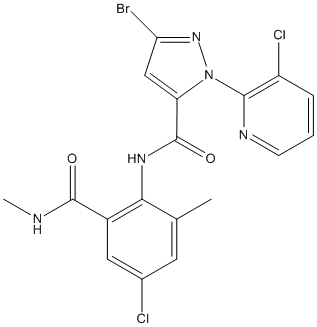Chlorantraniliprole
General
Type : Insecticide || Carbamate || Pyridine || Carboxamide || Pyrazole
Chemical_Nomenclature : 5-bromo-N-[4-chloro-2-methyl-6-(methylcarbamoyl)phenyl]-2-(3-chloropyridin-2-yl)pyrazole-3-carboxamide
Canonical SMILES : CC1=CC(=CC(=C1NC(=O)C2=CC(=NN2C3=C(C=CC=N3)Cl)Br)C(=O)NC)Cl
InChI : InChI=1S\/C18H14BrCl2N5O2\/c1-9-6-10(20)7-11(17(27)22-2)15(9)24-18(28)13-8-14(19)25-26(13)16-12(21)4-3-5-23-16\/h3-8H,1-2H3,(H,22,27)(H,24,28)
InChIKey : PSOVNZZNOMJUBI-UHFFFAOYSA-N
Other name(s) : Rynaxpyr, DPX-E2Y45

Target
Families : No family
References (10)
| Title : An investigation of the molecular and biochemical basis underlying chlorantraniliprole-resistant Drosophila strains and their cross-resistance to other insecticides - Kim_2018_Arch.Insect.Biochem.Physiol__e21514 |
| Author(s) : Kim AY , Kwon DH , Jeong IH , Koh YH |
| Ref : Archives of Insect Biochemistry & Physiology , :e21514 , 2018 |
| Abstract : Kim_2018_Arch.Insect.Biochem.Physiol__e21514 |
| ESTHER : Kim_2018_Arch.Insect.Biochem.Physiol__e21514 |
| PubMedSearch : Kim_2018_Arch.Insect.Biochem.Physiol__e21514 |
| PubMedID: 30397935 |
| Title : Response of detoxification and immune genes and of transcriptome expression in Mythimna separata following chlorantraniliprole exposure - Wang_2018_Comp.Biochem.Physiol.Part.D.Genomics.Proteomics_28_90 |
| Author(s) : Wang JD , Wang WZ , Wang YR , Gao SJ , Elzaki M , Wang R , Wu M |
| Ref : Comparative Biochemistry & Physiology Part D Genomics Proteomics , 28 :90 , 2018 |
| Abstract : Wang_2018_Comp.Biochem.Physiol.Part.D.Genomics.Proteomics_28_90 |
| ESTHER : Wang_2018_Comp.Biochem.Physiol.Part.D.Genomics.Proteomics_28_90 |
| PubMedSearch : Wang_2018_Comp.Biochem.Physiol.Part.D.Genomics.Proteomics_28_90 |
| PubMedID: 30005390 |
| Title : Influence of soil temperature and moisture on biochemical biomarkers in earthworm and microbial activity after exposure to propiconazole and chlorantraniliprole - Hackenberger_2017_Ecotoxicol.Environ.Saf_148_480 |
| Author(s) : Hackenberger DK , Palijan G , Loncaric Z , Jovanovic Glavas O , Hackenberger BK |
| Ref : Ecotoxicology & Environmental Safety , 148 :480 , 2017 |
| Abstract : Hackenberger_2017_Ecotoxicol.Environ.Saf_148_480 |
| ESTHER : Hackenberger_2017_Ecotoxicol.Environ.Saf_148_480 |
| PubMedSearch : Hackenberger_2017_Ecotoxicol.Environ.Saf_148_480 |
| PubMedID: 29121590 |
| Title : cDNA cloning and characterization of the carboxylesterase pxCCE016b from the diamondback moth, Plutella xylostella L. - Yasin_2020_Arch.Microbiol__ |
| Author(s) : Hu ZD , Feng X , Lin QS , Chen HY , Li ZY , Yin F , Liang P , Gao XW |
| Ref : Journal of Integrative Agriculture , 15 :1059 , 2016 |
| Abstract : Yasin_2020_Arch.Microbiol__ |
| ESTHER : Yasin_2020_Arch.Microbiol__ |
| PubMedSearch : Yasin_2020_Arch.Microbiol__ |
| PubMedID: |
| Gene_locus related to this paper: pluxy-a0a088qel8 |
| Title : Biochemical basis of synergism between pathogenic fungus Metarhizium anisopliae and insecticide chlorantraniliprole in Locusta migratoria (Meyen) - Jia_2016_Sci.Rep_6_28424 |
| Author(s) : Jia M , Cao G , Li Y , Tu X , Wang G , Nong X , Whitman DW , Zhang Z |
| Ref : Sci Rep , 6 :28424 , 2016 |
| Abstract : Jia_2016_Sci.Rep_6_28424 |
| ESTHER : Jia_2016_Sci.Rep_6_28424 |
| PubMedSearch : Jia_2016_Sci.Rep_6_28424 |
| PubMedID: 27328936 |
| Title : Life history and biochemical effects of chlorantraniliprole on Chironomus riparius - Rodrigues_2014_Sci.Total.Environ_508C_506 |
| Author(s) : Rodrigues AC , Gravato C , Quintaneiro C , Golovko O , Zlabek V , Barata C , Soares AM , Pestana JL |
| Ref : Sci Total Environ , 508C :506 , 2014 |
| Abstract : Rodrigues_2014_Sci.Total.Environ_508C_506 |
| ESTHER : Rodrigues_2014_Sci.Total.Environ_508C_506 |
| PubMedSearch : Rodrigues_2014_Sci.Total.Environ_508C_506 |
| PubMedID: 25526627 |
| Title : Determination of baseline susceptibility of European populations of Tuta absoluta (Meyrick) to indoxacarb and chlorantraniliprole using a novel dip bioassay method - Roditakis_2013_Pest.Manag.Sci_69_217 |
| Author(s) : Roditakis E , Skarmoutsou C , Staurakaki M , Martinez-Aguirre Mdel R , Garcia-Vidal L , Bielza P , Haddi K , Rapisarda C , Rison JL , Bassi A , Teixeira LA |
| Ref : Pest Manag Sci , 69 :217 , 2013 |
| Abstract : Roditakis_2013_Pest.Manag.Sci_69_217 |
| ESTHER : Roditakis_2013_Pest.Manag.Sci_69_217 |
| PubMedSearch : Roditakis_2013_Pest.Manag.Sci_69_217 |
| PubMedID: 23034903 |
| Title : Biochemical characterization of chlorantraniliprole and spinetoram resistance in laboratory-selected obliquebanded leafroller, Choristoneura rosaceana (Harris) (Lepidoptera: Tortricidae) - Sial_2011_Pestic.Biochem.Physiol_99_274 |
| Author(s) : Sial AA , Brunner JF , Garczynski SF |
| Ref : Pesticide Biochemistry and Physiology , 99 :274 , 2011 |
| Abstract : Sial_2011_Pestic.Biochem.Physiol_99_274 |
| ESTHER : Sial_2011_Pestic.Biochem.Physiol_99_274 |
| PubMedSearch : Sial_2011_Pestic.Biochem.Physiol_99_274 |
| PubMedID: |
| Title : Feeding cessation effects of chlorantraniliprole, a new anthranilic diamide insecticide, in comparison with several insecticides in distinct chemical classes and mode-of-action groups - Hannig_2009_Pest.Manag.Sci_65_969 |
| Author(s) : Hannig GT , Ziegler M , Maron PG |
| Ref : Pest Manag Sci , 65 :969 , 2009 |
| Abstract : Hannig_2009_Pest.Manag.Sci_65_969 |
| ESTHER : Hannig_2009_Pest.Manag.Sci_65_969 |
| PubMedSearch : Hannig_2009_Pest.Manag.Sci_65_969 |
| PubMedID: 19449341 |
| Title : Liquid chromatography-tandem mass spectrometric ion-switching determination of chlorantraniliprole and flubendiamide in fruits and vegetables - Caboni_2008_J.Agric.Food.Chem_56_7696 |
| Author(s) : Caboni P , Sarais G , Angioni A , Vargiu S , Pagnozzi D , Cabras P , Casida JE |
| Ref : Journal of Agricultural and Food Chemistry , 56 :7696 , 2008 |
| Abstract : Caboni_2008_J.Agric.Food.Chem_56_7696 |
| ESTHER : Caboni_2008_J.Agric.Food.Chem_56_7696 |
| PubMedSearch : Caboni_2008_J.Agric.Food.Chem_56_7696 |
| PubMedID: 18690687 |